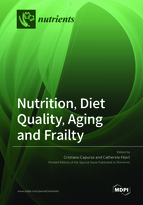Nutrition, Diet Quality, Aging and Frailty
A special issue of Nutrients (ISSN 2072-6643). This special issue belongs to the section "Nutritional Epidemiology".
Deadline for manuscript submissions: closed (28 February 2021) | Viewed by 52718
Special Issue Editors
Interests: cognitive decline; atherosclerosis; diet pattern; aging; frailty
Special Issues, Collections and Topics in MDPI journals
Interests: epidemiology; nutrition; dietary patterns; aging; dementia; geriatric syndromes
Special Issues, Collections and Topics in MDPI journals
Special Issue Information
Dear Colleagues,
In the last century, the average life expectancy at birth increased from roughly 45 years in the early 1900s to more than 80 years today. However, living longer is often related to different levels of frailty. There is no curative treatment for frailty—the interventions that have been described as effective to slow or delay the onset of frailty are physical activity and nutritional interventions. The impact of diet and lifestyle on health status is well established. Maintaining adequate nutrition status is important to reduce the risk of chronic diseases, many of which are age-related. On the other hand, frailty itself may have a negative effect on eating and, thus, on the nutritional status.
This Special Issue of Nutrients, entitled “Nutrition, Diet Quality, Aging and Frailty”, has been developed to compile contemporary research studies on this important topic. We invite you and your collaborators to consider the submission of your original research, protocol development, and methodological studies, narrative or systematic reviews, and meta-analyses. To better understand these complex relationships, we welcome all types of study designs in various populations, including large observational epidemiological studies, systematic reviews and meta-analyses, clinical and field trials, and qualitative investigations.
Dr. Cristiano Capurso
Prof. Catherine Féart
Guest Editors
Manuscript Submission Information
Manuscripts should be submitted online at www.mdpi.com by registering and logging in to this website. Once you are registered, click here to go to the submission form. Manuscripts can be submitted until the deadline. All submissions that pass pre-check are peer-reviewed. Accepted papers will be published continuously in the journal (as soon as accepted) and will be listed together on the special issue website. Research articles, review articles as well as short communications are invited. For planned papers, a title and short abstract (about 100 words) can be sent to the Editorial Office for announcement on this website.
Submitted manuscripts should not have been published previously, nor be under consideration for publication elsewhere (except conference proceedings papers). All manuscripts are thoroughly refereed through a single-blind peer-review process. A guide for authors and other relevant information for submission of manuscripts is available on the Instructions for Authors page. Nutrients is an international peer-reviewed open access semimonthly journal published by MDPI.
Please visit the Instructions for Authors page before submitting a manuscript. The Article Processing Charge (APC) for publication in this open access journal is 2900 CHF (Swiss Francs). Submitted papers should be well formatted and use good English. Authors may use MDPI's English editing service prior to publication or during author revisions.
Keywords
- Mediterranean Diet
- nutrients
- aging
- frailty
- cognitive decline








